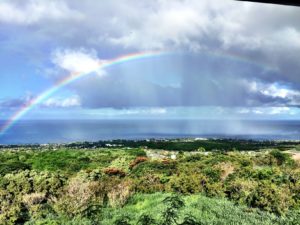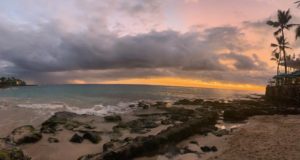 The Kilauea eruption ended last August, and when the eruption ended, so did the sulfuric volcanic fog (VOG). When the VOG stopped, Hawaii Island enjoyed its first prolonged clean air experience in 33 years since the volcano first erupted in 1983. What the island may not have expected is a new weather pattern that some long time residents say was the weather pattern BEFORE the eruption in 1983, but may also be the start of a new normal due to a changing climate. Whatever the reason, choosing where you wish to buy a home on the Big Island to either avoid the heat or the rain, may take a bit more research.
The Kilauea eruption ended last August, and when the eruption ended, so did the sulfuric volcanic fog (VOG). When the VOG stopped, Hawaii Island enjoyed its first prolonged clean air experience in 33 years since the volcano first erupted in 1983. What the island may not have expected is a new weather pattern that some long time residents say was the weather pattern BEFORE the eruption in 1983, but may also be the start of a new normal due to a changing climate. Whatever the reason, choosing where you wish to buy a home on the Big Island to either avoid the heat or the rain, may take a bit more research.
While for most of Hawaii, the winter months are generally the rainiest, Kona’s drier season is generally from November through March, while the rainy season runs from April through October. And OH! what a rainy season it has been this year!
RAIN RAIN RAIN
On average, Kailua Kona receives about 18.4 inches (467 mm) of rain per year. Most of the rain falls at night and early morning, and daytime showers are usually intense, but short-lived.
Waiaha, on the slopes of Hualalai in North Kona, recorded the highest rainfall total of any Big Island spot for the month of August 2019, 15.96 inches, more than three times its August average of 4.71 inches. The rain gauge in Kainaliu, South Kona, weighed in at 10.34 inches, almost twice its 5.83 August average according to the Hawaii Tribune Herald. In fact, records for the highest rainfall total in August were broken at Kealakekua and tied at Honaunau with 14.54 inches and 10.34 inches, respectively, almost 2 1/2 times the average August rainfall of 6.05 inches in Kealakekua and almost twice the usual August rainfall of 5.83 inches in Honaunau. To note, from April 1st until the end of September, Holualoa recorded 90 inches of rain.
“This summer has been pretty erratic. Some of that is due to abnormal trade winds. They’ve been coming in a different direction than normal and causing changes in rainfall distribution, but from late August to the current time, we’ve been picking up a little more normal trade wind direction and speed. So that’s been helping with the rainfall,” stated Kevin Kodama, NWS Hydrologist.
HOT HOT HOT
And let’s talk about the heat. Chevy Chevalier, National Weather Service meteorologist, said every summer brings a few record highs. But this year, Hawaii has seen more than what’s normal. According to an article about the heat wave across the Hawaiian Islands this summer from Hawaii News Now, the National Weather Service says Hilo has tied 13 heat records since May and set eight new ones. On June 25, the temperature in Hilo topped 88 degrees, breaking the previous high of 87 set in 1969. Kailua Kona saw quite a few days of temperatures hitting 90 degrees.
Some long time residents have also noticed that without the VOG, which created a sun deflecting “nuclear winter” for years, that clear sunny days are MUCH warmer than they have been over the last three decades.
Determining the New Normal

According to the National Oceanic Atmospheric Association (NOAA), the ocean heat wave of 2015 and now the ocean heat wave of 2019 have created conditions that may never entirely return to normal. The much warmer ocean has contributed to the conditions that have brought the record rainfall and heat to Hawaii. Knowing this information will help you have a deeper conversation with your REALTOR about how much heat and or rain can you put up with to feel comfortable where you live.
Many residents purposely choose to live above the 800 foot elevation to escape the heat, but now find themselves in a new rain shadow. Residents who did not mind the summer/early fall heat at ocean level are cranking up their air conditioning units and noticing the four degree rise in normal daytime highs.
Home Prices Track Comfortability
If you look at home prices in Kailua Kona above the town from Upper Palisades all the way to Keauhou, the price of homes rises the higher you get due to the expansive view, as well as the more moderate temperatures and weather patterns. The views will always remain the same, but you may need to take into consideration the new rain and heat patterns when choosing a home. Some people love the rain, which brings a cooler temperature, but also brings in more moist air into your home. More heat causes your electricity bill to rise. Both of these aspects of lifestyle are part and parcel to determining where you want to buy a home.
Even with the rain and the heat, West Hawaii is still a fantastic place to live and call home. LUVA Real Estate agents can work with you in discussing where in West Hawaii you will feel the most comfortable and which neighborhood will be best suited for your needs. Contact us today and let us talk to you about your options.